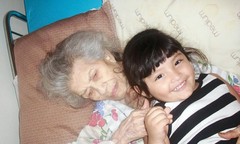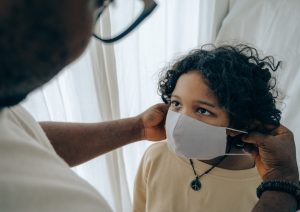LatinaLista — The sad case reported this week of 91-year-old Maria “Concha” Lopez, who died weighing 35 pounds and covered in bed sores while in the care of her 26-year-old great-niece Stephanie Hernandez, highlights a growing problem facing the Latino community — what do we do with our elderly?
It used to be unheard of to send our abuelos to a nursing home to live out their days when family was available to care for them. The guilt factor for one thing was enough to make sons and daughters question their roles as dutiful offspring. The cultural expectation of caring for parents at home can play out even stronger.

Maria “Concha” Lopez holds on to her niece’s daughter.
(Photo: Stephanie Hernandez)
In the case of Concha Lopez, the niece is now facing a murder charge and accused, not of violence towards her great-aunt, for whom she cared for three years, but for failing as a caregiver.
The truth may be that the niece was just too overwhelmed with the care of her great-aunt, who, according to reports, stubbornly refused to see anybody outside the family — including doctors or hospice workers.
Experts in the niece’s defense say that while Concha only weighed 35 pounds it was because of being at home that she even lived weighing that much.
Researchers see the probability of more cases like Concha’s escalating in the future within the Latino community as more and more families take it upon themselves to care for their elders, though they may not be the best option.
Dr. Jacqueline Angel, professor of Sociology and Public Affairs at the University of Texas at Austin, and a co-investigator on an NIH/National Institute on Aging study of the longitudinal health of older Mexican Americans in the Southwestern United States, has extensively studied the intersection of family, health and aging among Latinos.
In the following piece, originally published on the University of Texas’ website, Dr. Angel explains why it’s important for not only Latino families to consider the inevitable question of caring for their elders but why it is an issue for policymakers as well.
Aging in America: The Latino perspectiveBy Jacqueline AngelOne of the mixed blessings of our modern society is an ever-increasing life expectancy.
For those of us with the advantages of good health and adequate income, those extra years are a gift. But for those who face a long period of disability and poverty, old age can be more daunting than rewarding, not only for the elderly but for their families as well.
For the growing population of elderly Latinos, of whom Mexican Americans are the largest subgroup, the future is particularly uncertain.
That population is projected to increase dramatically in the years to come, rising from the current 1.3 million to 14.7 million by 2050. The number of these individuals who are 85 and older — the so-called “frail elderly” or “oldest-old” — will also continue to grow.
Interestingly, despite its socioeconomic disadvantage, the Latino population as a whole actually has a higher life expectancy than its non-Latino counterparts, a phenomenon known as the “Latino paradox.” But this longevity has trade-offs, as Latinos — Mexican Americans in particular — tend to spend a larger number of years with chronic health problems than their non-Latino counterparts.
Experts are still trying to solve the puzzle, but the evidence suggests a strong link between poverty, lack of education, and the loss of the immigrant advantage through selective health risk behaviors, such as smoking and fast-food diets.
A longer period of incapacitation means a greater need for assistance, and therein lies a problem that has both economic and cultural aspects.
On the economic side, many Latinos spend their working lives in low-paying jobs that preclude saving for retirement. Even those who are eligible for Social Security often receive low benefits and rely heavily on publicly funded programs such as Medicaid that are at risk of continuing cutbacks and restructuring.
The tight economy also affects younger Latinos, with the escalating cost of living often making it difficult to support themselves and their children, much less their aging parents. The high unemployment rate for Latinos — 11.3 percent in March 2011 — further exacerbates the problem.
On the cultural side of the equation, although Latinos as a group are strongly tied to their families and place high value on intergenerational bonds, both economic realities and societal pressures are taking their toll. The time-honored traditions and expectations of caring for older parents at home as opposed to placing them in a nursing home are at a crossroads.
Who, then, will care for the burgeoning population of elderly Latinos, particularly that large number with serious disabilities?
As a sociologist who has spent many years studying the health and long-term care needs of this vulnerable population, I believe that the answer to that question depends on how a number of other important questions are addressed.
Over the 15 years since our first study of the living arrangements and long-term care expectations of older Mexican Americans the evidence that cultural tradition dictates the reliance on family for long-term care has not significantly altered. However, a larger proportion of the same group of Mexican-born and U.S.-born older adults now also cite economic and health constraints as reasons for living with family.
Research has also shown that among those of Mexican origin, individuals who migrated to the United States in mature adulthood have a higher life expectancy than individuals who migrated in childhood or midlife.
As noted earlier, however, living longer does not necessarily mean living well. Balancing quality-of-life issues — including cultural preferences — with harsh economic realities will become increasingly difficult, both for families and for those who fund and carry out public assistance programs.
Returning then, to the question of who will take care of our Latino elders when they are no longer able to take care of themselves, I suggest that each of us can assume some share of the responsibility.
One key to effective planning for the future is obtaining sound information, whether that be family members gathering facts about available assistance or policy researchers gathering data about demographic trends or public officials gathering forecasts on the economy.
Although it is difficult to predict how the current reforms in the health care and public assistance systems will affect various subgroups of the U.S. population, including the growing Mexican-American contingent, those reforms are not static. Changes will continue to be made in response to new circumstances and new information.
Jacqueline L. Angel is Professor of Sociology and Public Affairs at the University of Texas at Austin. She is particularly interested in evaluating the impact of policies on the health and well-being of Latinos, immigrants, and other vulnerable groups. She is currently developing a research agenda that focuses on the role of civil society and non-governmental organizations on the care of low-income elderly in the United States and Latin America.




